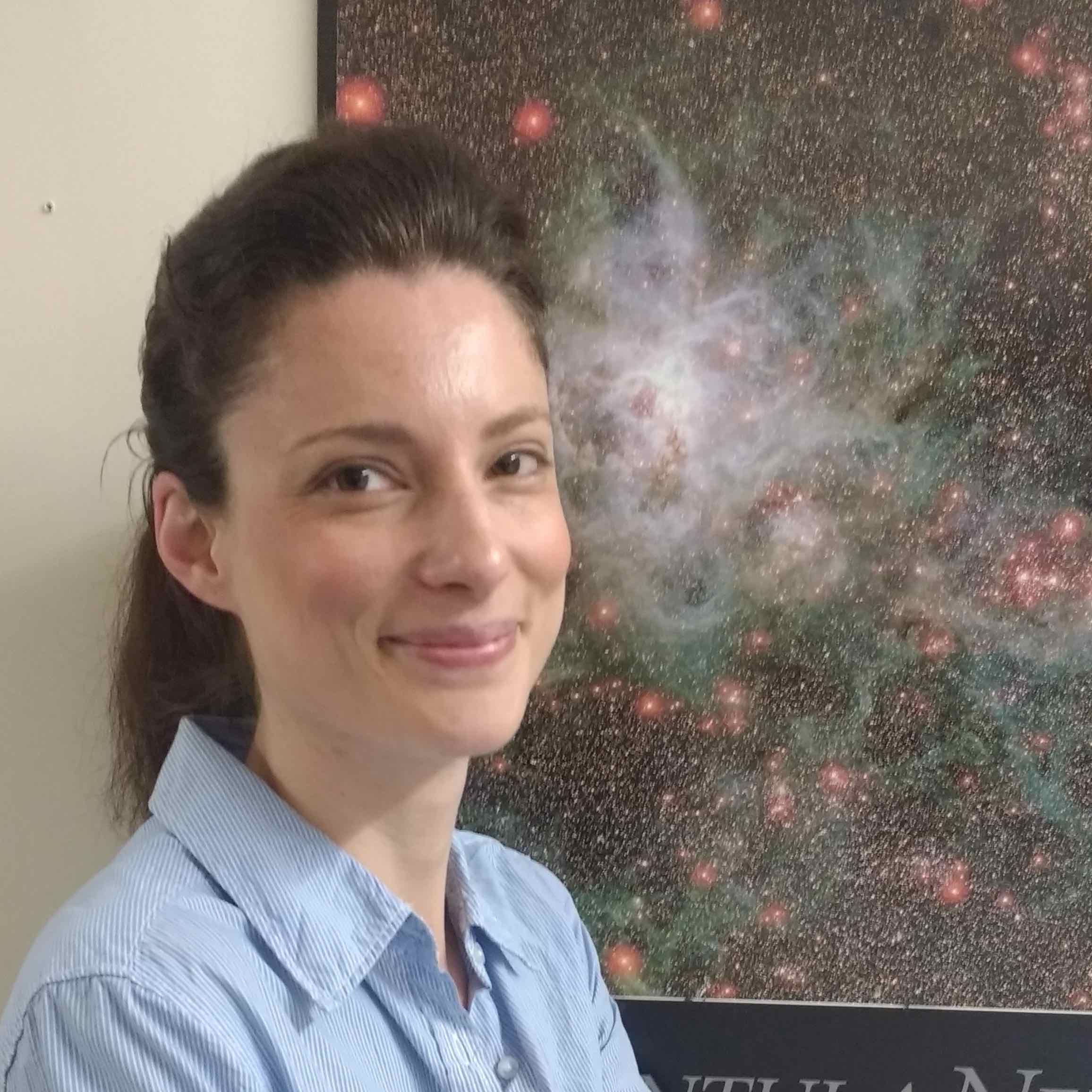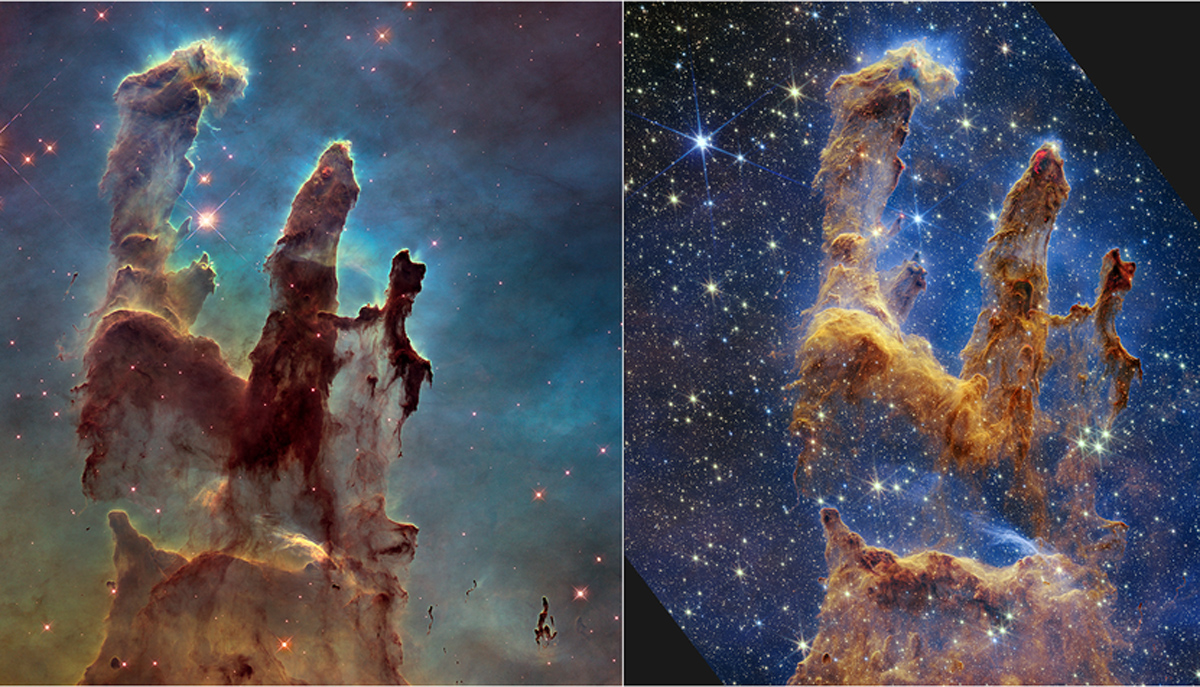The Eagle Nebula: Facts about the home of the Pillars of Creation
The Eagle Nebula is one of the most iconic sights you can view with a large telescope.

The Eagle Nebula, also known as the Star Queen Nebula or Messier 16 (M16 for short), is a cluster of stars and an area of active star formation about 5,700 light-years from Earth (it had previously been considered to reside 7,000 light-years away, but a recent study using data from the Gaia telescope published in the Astrophysical Journal in Jan. 2019 suggests its quite a bit closer.)
The Eagle Nebula is located in the constellation Serpens and covers an area of 70 by 55 light-years. It is home to the iconic Pillars of Creation, made famous by an image taken by the Hubble Space Telescope in 1995.
Though the nebula is not visible to the naked eye, you can see it using a small telescope or even a good pair of binoculars. It's most clearly visible in July, according to NASA. You would need a much larger telescope, along with good weather conditions, to see the Pillars of Creation.
Related: Orion Nebula: Facts about Earth’s nearest stellar nursery
The nebula is named for its shape, which is said to look like an eagle with outstretched wings. The name "Star Queen" comes from American astronomer Robert Burnham, Jr., who thought the central pillar of the galaxy looked like the silhouette of a Star Queen, according to the online Messier Objects catalog.
History and evolution of the Eagle Nebula
Object type: Diffuse emission nebula
Constellation: Serpens
Apparent Magnitude: +6
Age: 5.5 million years
Coordinates: 18h 18m 48s (right ascension), -13° 49′ 0″(declination)
Season: June to Sept. (best in July)
Distance from Earth: 5,700 light-years
The Eagle Nebula was discovered sometime in 1745 or 1764 by Swiss astronomer Jean-Philippe de Cheseaux, according to the online Messier Objects catalog. It was independently re-discovered the next year by French astronomer Charles Messier, who cataloged it as Messier 16 as part of his list of non-comet astronomical objects. Over a century later, American astronomer Edward Barnard became the first to create an image of the nebula in 1895.
At 5.5 million years old, the Eagle Nebula is fairly young (for comparison, our own sun is about 4.6 billion years old). According to NASA Hubble Site, our sun may have originally formed in a nebula like this one. Like all nebulas, it would have started out a cloud of cold hydrogen gas leftover from previous stars. The gas eventually began condensing into masses, which gradually heated up, eventually becoming so hot and dense that they began to fuse hydrogen into helium in their centers and became stars.
Breaking space news, the latest updates on rocket launches, skywatching events and more!
Parts of the Eagle Nebula are emission nebulas, meaning that the clouds of gas and dust are so hot they produce their own light. Other parts are dark nebulas, which are made of cold gas and are only visible because of the silhouettes they create against the nebula's glowing backdrop.
The Eagle Nebula was discovered sometime in 1745 or 1764 by Swiss astronomer Jean-Philippe de Cheseaux, according to the online Messier Objects catalog. It was independently re-discovered the next year by French astronomer Charles Messier, who cataloged it as Messier 16 as part of his list of non-comet astronomical objects. Over a century later, American astronomer Edward Barnard became the first to create an image of the nebula in 1895.
At 5.5 million years old, the Eagle Nebula is fairly young (for comparison, our own sun is about 4.6 billion years old). According to NASA Hubble Site, our sun may have originally formed in a nebula like this one. Like all nebulas, it would have started out a cloud of cold hydrogen gas leftover from previous stars. The gas eventually began condensing into masses, which gradually heated up, eventually becoming so hot and dense that they began to fuse hydrogen into helium in their centers and became stars.
Parts of the Eagle Nebula are emission nebulas, meaning that the clouds of gas and dust are so hot they produce their own light. Other parts are dark nebulas, which are made of cold gas and are only visible because of the silhouettes they create against the nebula's glowing backdrop.
The Pillars of Creation
Originally taken in 1995 by the Hubble Space Telescope, the Pillars of Creation is one of the most iconic astronomical images of all time. Despite their notoriety, the pillars represent only a small part of the Eagle Nebula, measuring 4 to 5 light-years across, according to NASA.
The distinctive structure of the pillars is created by a nearby cluster of massive stars called NGC 6611. Along with visible light, these stars shed huge amounts of charged particles, which clears dust and gas away. The dense areas of gas called evaporating gaseous globules shielded the area behind them from this solar wind, leading to the formation of the pillar structures.
The Hubble team revisited the Eagle Nebula and released an image in 2015 showing the feature in high-definition and near-infrared light. Both images show a wider view than the original and reveal more detail about the structure of the pillars. There are also slight differences between the two images as parts of the pillars are being eroded away by the radiation of charged particles, called solar winds, from nearby stars.
The 2015 near-infrared image pierces through much of the pillars' cold gas and dust, revealing the areas of star birth within the pillars. In 2022, James Webb Space Telescope took a similar near-infrared image of the pillars, revealing these areas of star birth in even greater detail.
In 2007, French astronomer Nicolas Flagey proposed in a study that based on data from NASA's Spitzer Space Telescope, a supernova explosion could have destroyed the pillars 6,000 years ago. But because the pillars are thousands of light-years away, they'd still be visible for many hundreds or even a thousand years in this case. But data since then hasn't confirmed the presence of a supernova, suggesting that while radiation from nearby stars is gradually eroding the pillars, they may exist for millions of years more.
Eagle Nebula FAQs answered by an expert
We asked Anna McLeod, an assistant professor of physics, a few commonly-asked questions about the Eagle Nebula.

Anna McLeod is an assistant professor of physics at the Centre for Extragalactic Astronomy at Durham University in the U.K.
What is special about the Eagle Nebula?
As star-forming regions (or stellar nurseries) come, the Eagle Nebula is not incredibly special. It has formed several massive stars which are responsible for "lighting up" the surrounding gas and creating the bubble-shaped cavity, which is typical for these types of regions. The three iconic pillars, or fingers (the so-called Pillars of Creation), are perhaps the most notable feature of this nebula. These types of structures are found in many other star-forming regions (see for example NGC 3603, or the Carina Nebula), but the ones in the Eagle Nebula are quite spectacular, leading to the fact that they have gained a lot of attention from the public, and that they have been the target for any new telescopes and instruments over the years.
Where in the Milky Way is the Eagle Nebula?
The Eagle Nebula is about 5,700 light-years from Earth, further towards the center of the Milky Way than we are (a nice figure is here). It lies about 0.8 degrees above the galactic plane, have a go at looking for it here at ~17 degrees in the horizontal direction and ~0.8 degrees in the vertical direction (if you hover over the image you can see the coordinates in the upper left corner, the image starts centered on the center of the Milky Way, just drag the image from left to right until you find the right ones and then zoom in!).
What created the "pillars" in the nebula's famous "Pillars of Creation"?
The pillars are created by the nearby massive stars that have formed in the region, and that form the star cluster NGC 6611. These massive stars output copious amounts of energy as they radiate and produce strong stellar winds, the combination of which acts like a snowplow that clears/pushes the surrounding gas and dust outwards. Dense pockets of gas along the way act as pebbles in a river, shielding the less dense gas behind them and creating a tail-like flow around them which naturally results in these structures. We refer to this as feedback from massive stars, which encompasses a variety of different physical mechanisms via which the stars interact with the surrounding material, and which is what my research focuses on.
Why do some scientists think these pillars were already destroyed?
Just as the feedback from the nearby massive stars is responsible for shaping the pillar-like structures, it is also destroying them via a process called photo-evaporation, which causes gas to stream away from the pillar surfaces and therefore making them lose mass. Over time, photo-evaporation will eventually fully erode the pillars. In my paper, we calculate their remaining lifetime to be about 3 million years.
A few years ago a paper by my colleague Nicolas Flagey suggested that there might have been a recent supernova explosion in the Eagle Nebula. Given the distance of the nebula and the suggested supernova age suggested in that paper (so considering that it takes the light coming from the nebula about 5,700 years to reach Earth, meaning that what we see is 5,700 years in the past), this would imply that the pillars might have already been destroyed. However, there is not enough observational evidence to confirm a recent supernova event in the region, which means that, for now, we can assume that the pillars are still there and being photo-evaporated!
Observing the Eagle Nebula
To locate the Eagle Nebula in the night sky, find the constellation Serpens, which has two distinct parts: Serpens Cauda (the serpent’s tail), and Serpens Caput (the serpent’s head). “The serpent” extends from either side of the trapezoid-like constellation Ophiuchus, the serpent-bearer. The Eagle Nebula sits in Serpens Cauda, which in mid-north latitudes, is to the bottom left of Ophiuchus, relatively close to the horizon at nightfall in June. It appears higher in the sky into the summer and early fall, becoming obscured by the horizon later in the night.
There are several other nebulas close by, such as the Omega Nebula in the constellation Sagittarius. The Eagle Nebula is recognizable by the eagle-like silhouette of the dark part of the nebula that it is named for.
Even in dark skies, you’ll need a low-powered telescope or pair of binoculars to observe the Eagle Nebula. However, the nebula should be visible using these tools even in moderately light-polluted areas, according to skywatching website Astro Backyard.
If you have a computerized telescope mount, you can simply enter M16 for Messier 16, or NGC 6611, the bright star cluster embedded in the nebula, and the mount will direct your telescope to the correct location.
If you're looking for a telescope or binoculars to observe the Eagle Nebula, check our guide for the best binoculars deals and the best telescope deals now. If you need imaging gear, consider our best cameras for astrophotography and best lenses for astrophotography.
A nebula in X-ray vision
In a 2012 study, researchers combined imaging data from Hubble with NASA's Chandra X-ray Observatory to study which stars in the Eagle Nebula emitted X-rays. Many stars, including our sun, emit this extremely high-energy radiation from their corona, or their outer atmosphere when it reaches temperatures over a million degrees Celsius.
Though the study identified over 1,700 sources of X-ray radiation, 1,183 of which came from within the Eagle Nebula, only one of these sources was likely to have come from within the star-forming Pillars of Creation. This could mean that the Pillars' protostars, or stars in the process of being born, may not yet have a coronas hot enough to produce X-ray radiation.
Most of the X-ray sources — over two-thirds — came from the young star cluster NG 6611, the same cluster responsible for shaping and illuminating the Pillars of Creation. Though the 964 stars with the strongest X-rays were surrounded by minimal dust and gas, a smaller fraction, 219 stars, were surrounded by disks of dust and gas that seemed to dull their X-rays. Though some of these disks will eventually be swept away by the solar wind, some may eventually become planets, forming solar systems like our own.
Additional resources
Explore the Eagle Nebula in different wavelengths with this interactive image from View Space. Read about the life cycle of stars in more detail with these resources from NASA Hubblesite. Take a deeper look at the night sky with NASA's interactive Messier sky map and learn more about the iconic Messier Catalog of astronomical objects that can be observed from Earth's Northern Hemisphere.
Bibliography
NASA. Messier 16 (The Eagle Nebula). Accessed April 20, 2023. From: https://www.nasa.gov/feature/goddard/2017/messier-16-the-eagle-nebula
NASA Hubblesite. Hubble Goes High Def to Revisit The Iconic 'Pillars of Creation'. Accessed April 20, 2023. From:
https://hubblesite.org/contents/news-releases/2015/news-2015-01.html#section-id-2
NASA. 'X'-ploring the Eagle Nebula and 'Pillars of Creation'. Accessed April 20, 2023. From: https://www.nasa.gov/mission_pages/chandra/images/x-ploring-the-eagle-nebula-and-pillars-of-creation.html
NASA. NASA's Webb Takes Star-Filled Portrait of Pillars of Creation. Accessed April 20, 2023. From: https://www.nasa.gov/feature/goddard/2022/nasa-s-webb-takes-star-filled-portrait-of-pillars-of-creation
ESA. Observations: Seeing in X-ray wavelengths. Accessed April 20, 2023. From: https://www.esa.int/Science_Exploration/Space_Science/Observations_Seeing_in_X-ray_wavelengths
The Astrophysical Journal. Chandra/ACIS-I Study of The X-Ray Properties of The NGC 6611 And M16 Stellar Populations. Accessed April 20, 2023. From:
https://iopscience.iop.org/article/10.1088/0004-637X/753/2/117
ESA. Stellar Spire in the Eagle Nebula. Accessed April 20, 2023. From:
https://sci.esa.int/web/hubble/-/37006-stellar-spire-in-the-eagle-nebula
Messier 16: Eagle Nebula. Accessed April 20, 2023. From:
https://www.messier-objects.com/messier-16-eagle-nebula/
Pillars of Creation Toppled by Stellar Blast. Accessed April 20, 2023. From: https://www.space.com/3154-pillars-creation-toppled-stellar-blast.html
The Awesome Beauty of the Eagle Nebula. Access April 20, 2023. From:
https://earthsky.org/clusters-nebulae-galaxies/the-awesome-beauty-of-m16-the-eagle-nebula/

Rebecca Sohn is a freelance science writer. She writes about a variety of science, health and environmental topics, and is particularly interested in how science impacts people's lives. She has been an intern at CalMatters and STAT, as well as a science fellow at Mashable. Rebecca, a native of the Boston area, studied English literature and minored in music at Skidmore College in Upstate New York and later studied science journalism at New York University.



